
Journal of Clinical Toxicology
Open Access
ISSN: 2161-0495

ISSN: 2161-0495
Case Report - (2023)Volume 13, Issue 1
“Nuvan” is a trading name of Dichlorvos (DDVP) organophosphate insecticide. The lethal dose of DDVP is very low for oral and dermal exposure, hence classified as a highly hazardous pesticide by WHO. Nuvan contains 76% DDVP and is accessible in India after the recent ban. Nuvan Insecticide is highly misused and orally ingested in suicide attempts. Insecticide poisoning is one of the leading causes of poisoning deaths in Indian rural areas. In this case series, we have diagnosed the four poisoning deaths by Nuvan-dichlorvos insecticide through post-mortem examination and toxicological analysis. The stomach and contents were grossly examined, a fluorescent turquoise blue liquid content was found throughout the stomach and small intestine. Liquid content had a notable odor of Volatile Organic Compounds (VOCs). The mucosal walls of the stomach were highly congested and hemorrhagic. These gross characteristics of stomach content are significant for screening Nuvan insecticide. Toxicological analyses were performed for the stomach and content by Thin Layer Chromatography (TLC) using spraying reagent and DDVP was detected. As of now, the ministry of agriculture and farmers welfare (India) has completely banned the use of DDVP, but there are still chances to encounter Nuvan as the fatal cases were reported after prohibition. Thus, the simple gross examination of gastrointestinal viscera (stomach and intestine) is supporting diagnostic evidence for orally administered insecticide. Nuvan can also be screened through gastric lavage. The toxicological analysis has to be performed for the chemical confirmation and will determine illegitimate pesticides that are still available in the market and threatening life.
Pesticide poisoning; Dichlorvos (DDVP); Forensic toxicology; Thin Layer Chromatography (TLC); Nuvan insecticide; Post-mortem examination; Clinical toxicology
Organic Phosphorus Pesticides (OPs) are the cholinesterase inhibitors that can reversibly or irreversibly bind with the serine residue in the active site of the enzyme acetylcholinesterase and prevent the normal functioning of neurotransmitters [1]. This action is not limited to insects but can produce toxicity in animals and humans [2]. OP insecticides refer to Phosphorus (P) containing compounds with various structural types including phosphates, that have four oxygen atoms surrounded by central Phosphorus (P) atom as Dichlorvos (DDVP) (Figure 1). DDVP is the dimethylated OPs that belong to the fourth class of phosphate pesticides, bonded with two methoxy groups at the R1 and R2 position (Figure 1) [3].
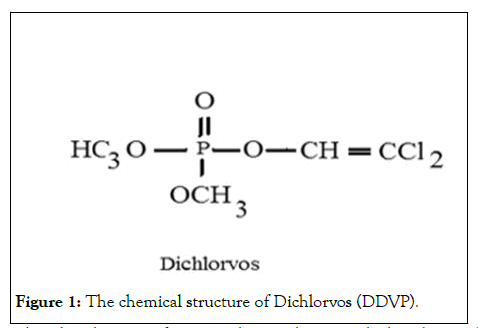
Figure 1: The chemical structure of Dichlorvos (DDVP).
Phosphoryl group of OP attaches to the active hydroxyl site of the Acetylcholinesterase (Ache) and inactivates the enzyme which leads to the accumulation of excessive Acetylcholine (Ach) at the cholinergic junction that disrupts the normal synaptic transmissions (Reaction 1) (Figure 2). The inactive ache enzyme also regenerates by removing the phosphate moiety attached to it by hydroxyl ion reaction and releases back the active enzyme (Reaction 2) (Figure 2) [4]. But this regenerative process is much slower than inhibition and takes hours to days depending on the chemistry of the substituted phosphate. Enzyme inactivated by Dimethylated OPs takes 0.7 hours-86 hours to regenerate back 6. During the inactive state, the enzyme is also prone to “aging” in which one alkyl side chain of the phosphoryl moiety is removed and leaves a hydroxyl group as a substitute (Reaction 3) (Figure 2) [5].
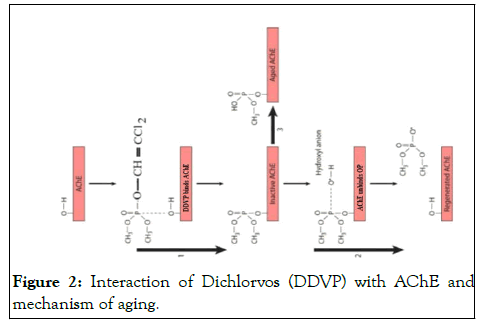
Figure 2: Interaction of Dichlorvos (DDVP) with AChE and mechanism of aging.
“Aged” ache cannot regenerate and this reaction occurs faster with enzymes that have been inhibited by dimethylated pesticides as in the case with DDVP (t½ hours-3.3 hours) [6]. Therefore, oximes are only effective if given within 12 hours of poisoning by dimethylated OPs as inactive enzyme rapidly converts into aged enzyme before going into regeneration and produces ageddimethylphosphoryl- ache, generally resistant to oxime therapy. Dichlorvos is defined by WHO as a class ɪb highly hazardous pesticide as it has a very low LD50 value for oral and dermal exposure. Acute ingestions can become symptomatic quickly, onset the complications of aspiration and respiratory failure that causes the majority of deaths before medical assistance could be provided. In addition to the risk of occupational and environmental toxicity, pesticides are the trending method of suicide in rural areas and kill over 2,00,000 people annually [7]. In several countries, dichlorvos is prohibited to minimize the suicidal, occupational, and accidental poisonings [8]. Dichlorvos insecticide is accessed in India with different trade names such as Agrovan 76, Agro 76EC, Divisol, Nuvan, Nuvasuls 76, Bangvas, DDVP, Divap, and D-aivisol. Nuvan contains 76% of dichlorvos, the most common brand available in India, accessible even after the ban, and uncontrolled selling is threatening to life. The frequency of toxic or fatal events in India suggests that they are still easily accessed. In developing nations, Emergency medicine in hospitals lack clinical toxicological laboratories and such pesticidal poisonings are left unnoticed. Therefore, there is a need of detecting toxic compounds in biological matrices which will have a major impact on pesticide management authorities. Toxicological analyses are necessary for identifying unlicensed products in the market and equally important for medical treatment. As alternative blood ache activity can indicate cholinesterase inhibitors, but cannot confirm the xenobiotic chemical compound while medications should be followed as per the type of pesticide poisoning.
For instance, Carbamates (CA) also cause cholinergic crises but are clinically indistinguishable from OP poisoning. Pralidoxime is the antidote to OP intoxication but is considered to be contraindicated in CA poisoning. Also, the In-vitro half-life of human ache after poisoning with dimethoxy OPs is 3.7 hours as compared to 31 hours in cases of diethoxy OPs. Hence, the oxime therapy is time bounded for dimethoxy OPs. Analytical extraction of pesticides from viscera or lavage is the first crucial step for analysis. Solvent extraction method is one of the best suitable techniques for the extraction of pesticide residues from aqueous biological fluids such as gastric lavage/vomit. Solvent extraction is dependent on the hydrophobicity and miscibility of compounds, hence polar and non-polar pesticides are extracted accordingly. This study aims to simple, rapid, and inexpensive detection of DDVP in biological matrices and gross findings of gastrointestinal tract as diagnostic reference for Nuvan insecticide poisonings [9].
Four fatal cases with an alleged history of Nuvan insecticide and unknown substance consumption were autopsied. Three cases were brought dead without any prior treatment and one case was hospitalized. The admitted patient was on medical assistance; underwent gastric lavage; Atropine and Pralidoxime IV were injected as per treatment protocol. During post-mortem, the whole stomach was grossly examined, sensed for odor, and photographs were taken. The stomach and its contents were chemically analysed by TLC with a spraying reagent and DDVP was detected in all cases [10].
Case findings
Case 1: 48-year aged male brought dead to emergency with the history and police intimation of self-ingested Nuvan insecticide. Gross examination of the GI tract revealed fluorescent turquoise blue coloured liquid content throughout the stomach and small intestine. Content had a notable odor of Volatile Organic Compounds (VOCs). Stomach mucosal walls were highly congested and hemorrhagic (Figures 3) [11].
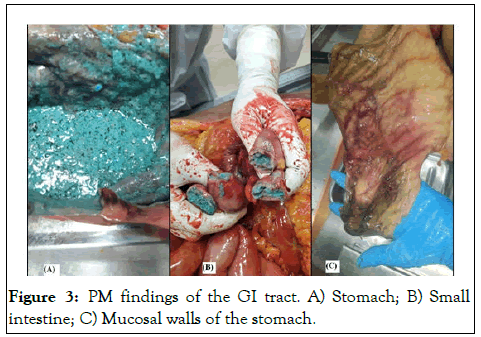
Figure 3: PM findings of the GI tract. A) Stomach; B) Small intestine; C) Mucosal walls of the stomach.
Case 2: 52-year aged male brought dead to the hospital with police intimation of insecticide poisoning. Gross examination of the GI tract revealed turquoise blue-coloured liquid content in the stomach, adhered to congested and hemorrhagic mucosal walls (Figure 4). Pungent odor of VOCs was sensed [12].
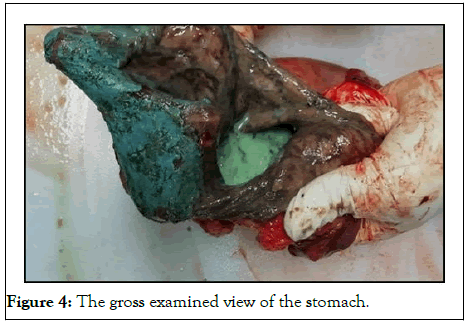
Figure 4: The gross examined view of the stomach.
Case 3: 38-year aged male, brought dead with a history of unknown substance uptake. PM examination showed turquoise blue coloured content in the stomach and upper abdominal cavity (Figure 5A and 5B). The content was leaked to the abdomen due to the perforated hole in the stomach wall (Figure 5C). Pungent odor of VOCs was sensed [13].
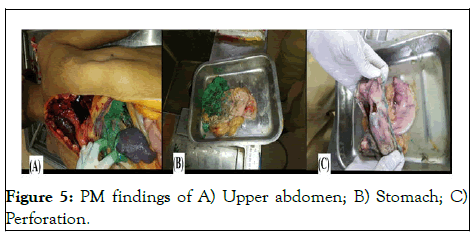
Figure 5: PM findings of A) Upper abdomen; B) Stomach; C) Perforation.
Case 4: 22- year aged female, admitted to the hospital in an unconscious state with a history of unknown substance uptake. Patient suffered prolonged emesis, convulsions, and abdominal pain and died after a week on ventilatory support. The stomach and its mucosal walls were highly hemorrhagic (Figure 6A). Dark bluish charred content was found adhered to the mucosal walls of the stomach (Figure 6B) [14].
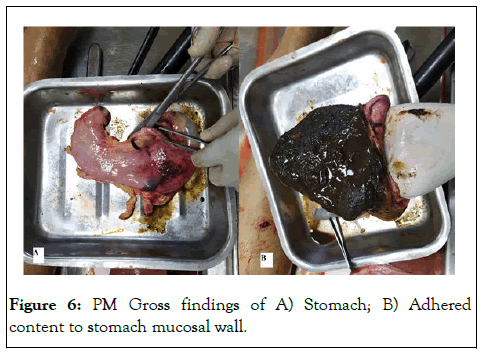
Figure 6: PM Gross findings of A) Stomach; B) Adhered content to stomach mucosal wall.
Toxicological analyses
Analytes were extracted from stomach matrices through the solvent extraction method via acetonitrile and chloroform solvent. Acetonitrile is used as a aqueous phase (polar solvent) to extract Polar pesticides such as-DDVP. Acetonitrile is highly efficient to extract hydrophobic substances containing polar groups from hydrocarbons and fatty matrices. 50 grams of macerated stomach tissue with content was dissolved in 100 ml of acetonitrile, evaporated on a water bath for 30 minutes, and filtered through anhydrous magnesium sulfate.
Anhydrous salt absorbs the residual water and the possibility of analyte preconcentration by evaporation.
Extracted analyte solution was collected and further separated in a separating funnel. Adding chloroform (25 ml) in the separating funnel with no influence on the acetonitrile content in the aqueous phase, thus leading to decreasing the coextraction of non-polar matrix components by salting out. Shaking the funnel for 1 minute-2 minute (inverting the separating funnel approximately 5-6 times), this process allows thorough interspersion of extracted analyte to the aqueous phase, assisting mass transfer and allowing efficient partitioning to occur. After 5 minutes of the resting period, both the phases get stable and partitioned in a funnel.
Chloroform has a high density to the acetonitrile, acquires a lower layer in a funnel, and is eluted out. The Acetonitrile layer was collected and passed through anhydrous magnesium sulfate and the final analyte sample was prepared. The final sample analyte was loaded on a silica gel TLC plate (10 cm × 10 cm), and parallelly ran with Dichlorvos Standard (DS) in the nhexane: Ethyl acetate: Methanol (7:1.5:1.5) solvent system for 30 minutes. The developed TLC plate is sprayed with 1% phenyl hydrazine hydrochloride solution and after 5 minutes, a yellowish colour spot appears at RF=0.532. Further sprayed with 10%hydrochloric acid turns the spot to red coloured as positive confirmation for dichlorvos. Toxicological analyses done for all five cases showed a confirmatory detection for dichlorvos [15].
All four cases were reported from rural areas. The first three cases died before reaching the hospital and medical assistance could be provided. The prominent cause of death is hypoventilation and pulmonary dysfunction, which can onset within two minutes after DDVP poisoning. DDVP is a directacting OP compound that quickly inhibits acetylcholine enzymes without being metabolized in the body. The inhibited ache converts rapidly (t½ hours-3.3 hours) into “aged” ache (permanently irreversible). Clinically, this suggests that patients who admit to a hospital after 4 hours of poisoning with a DDVP, have 50% of their ache irreversibly inhibited and after 14 hours, the patients become completely resistant to oxime treatment. Therefore, Oximes should be given early within 2 hours-4 hours and are effective only within 12 hours after intoxication. Thus, in case 4, the patient brought to the 4 hours of poisoning did not survive, even intubated on a ventilator and medically treated. Also, the treatment doses of oxime are selective for dimethyl OPs. The reactivating potential of the oximes should be efficient and preventive for aged ache.
Reactivating potential of obidoxime for dimethylphosphoryl- Ache is considered superior to pralidoxime. Obidoxime is approximately 10 times-90 times more reactive than pralidoxime. Pralidoxime is effective as obidoxime if given at least five times a higher dose. In-vitro studies have shown that seven times as much pralidoxime as obidoxime is required for reactivation of dimethyl-OP inhibited AChE 34356519. During autopsy, stomach examination showed significant features of Nuvan insecticide poisoning in brought dead cases. The fluorescent turquoise blue coloured liquid content was found throughout the stomach to the small intestine. The content had an odor of volatile organic compound and was ingested Nuvan-dichlorvos insecticide.
Therefore, an orally ingested insecticide should be washed from the stomach to inhibit further absorption in the body. In case 4, the insecticidal content was found adhered to mucosal walls of the stomach, this suggested that lavage was incomplete. Patient suffered excruciating conditions on a ventilator for 7 days as persistence of the OP within the led to rapid re-inhibition of the reactivated enzymes. Stomach mucosal walls were highly congested and hemorrhagic in all four fatal cases. Case 3 had a rare finding of stomach perforation, which suggests DDVP may cause vascular endothelial dysfunction. Perforation was caused due to microvascular thrombosis by the contact of toxins with the mucosa for a longer duration. Solvents in the insecticide also contribute to mucosal erosions. Co-formulated solvents create toxicity and vary with OP and insecticidal brands 3. In the unavailability of Toxicological laboratories, all anticholinesterase poisonings are treated as the same, despite wide variation in their toxicity, fat solubility, metabolism, ache selectivity, and ageing rate, which affect poisoning severity and response to treatment. Chemical analyses performed to detect dichlorvos using TLC is a simple inexpensive technique, and the solvent extraction method is efficient to withdraw pesticides from aqueous biological fluids (stomach wash and vomiting).
Confirmation of OP compound is more reliable than plasma cholinesterase level for effective treatment. Development of Toxicology laboratories for such evaluation is essentially important for hospitals and forensic departments. In unavailability of clinical toxicological laboratories and higher analytical instruments, the simple TLC analyses can be performed for screening and preliminary identification. Ministry of Agriculture and welfare, India (GOI) has also banned the manufacture, import, and use of dichlorvos pesticide by year 2022 as it is highly hazardous, and uncontrolled regulations have led to deaths all over India.
Though legislative guidelines have banned the regulation of such pesticides but they are still associated with the risks of exposure. As small farmers and domestic users keep the stock they had before prohibiting laws were approved. There is a possibility to encounter poisoning or fatal cases of banned pesticides as the most common is Nuvan. As In all four cases, the Nuvan insecticide was orally ingested, hence the gross examination of GI tract is diagnostic evidence. There is a need for awareness among farmers, pest control workers, distributors regarding the prohibition and usage of pesticides. Also, it has become equally important for forensic departments to detect the poisonings by such unauthorised chemical compounds
This study was supported by the All India Institute of Medical Sciences (AIIMS), Rishikesh. The contents of this manuscript are solely the responsibitlity of the authors and does not include any external funding. Chauhan J would like to thank Chaudhary. BL and Bastia. BK for their encouragements and support for finalizing the manuscript.
Citation: Chauhan J (2023) Gross Examination and Toxicological analysis of Gastrointestinal Tract in Fatal Cases of Poisoning by Nuvan Insecticide: A Case Reoprt. J Clin Toxicol. 13: 526.
Received: 09-Aug-2022, Manuscript No. JCT-22-18773; Editor assigned: 12-Aug-2022, Pre QC No. JCT-22-18773 (PQ); Reviewed: 26-Aug-2022, QC No. JCT-22-18773; Revised: 26-Dec-2022, Manuscript No. JCT-22-18773 (R); Published: 02-Jan-2023 , DOI: 10.35248/2161-0495.23.13.526
Copyright: © 2023 Chauhan J. This is an open-access article distributed under the terms of the Creative Commons Attribution License, which permits unrestricted use, distribution, and reproduction in any medium, provided the original author and source are credited.